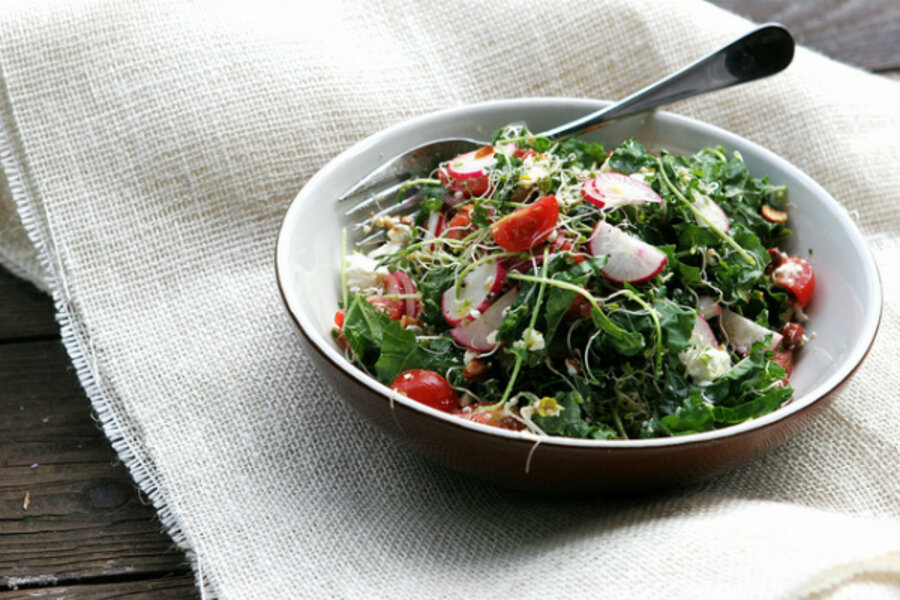How to eat more salad
Loading...
One of my New Year's resolutions is to eat more salad. Clearly, a salad resolution is easier than some others. If you know some tricks, that is. One thing I'm proud of is that my friends and family report their salads have gotten progressively tastier and more interesting as a result of being around me. A girl has to leave some sort of legacy, right? That's mine.
Now that I'm sitting here thinking about it, I guess I have a lot of opinions and tips when it comes to salad. Are you ready for this?
You don't need lettuce to make a salad. The one pictured here is curly kale and a couple huge handfuls of sprouts (which I'm really into right now and am growing on my kitchen counter). No lettuce. In the winter, cabbage is often the base of my salads. It's cheap, lasts forever in the fridge, and delivers a lot of nutritional bang for your buck.
Purchased salad dressing is a racket. A big one. Loaded with calories, expensive, and usually not very tasty. Often, I don't mix up a salad dressing. I just toss my whole salad with a big squeeze of lemon (or lime or vinegar), coarse salt and pepper, and a glug of olive oil. Just pour them right in the bowl and mix gently and well with your hands. If you're going to make dressing, the general rule is 1 part acid to 3 parts oil, plus salt (and pepper, if you're a pepper person). Of course you can endlessly variate this – honey, apple cider vinegar, olive oil and garlic. Cilantro, sesame and vegetable oil, miso paste, and soy sauce. Find a favorite combo, make a big batch, and use it all week.
A little bit of fat or protein goes a long way, especially if you make a "chopped salad" (as opposed to layered or composed). Some finely chopped almonds, a little bit of salami, ham turkey, bacon, or tuna, 1/2 a hard-boiled egg, a bit of crumbled feta or blue cheese, a handful of canned chickpeas, or a couple minced olives or anchovies are all you need to make your salad feel like a substantial meal. You can, of course, leave these things out, but I like finding those little nuggets in the tangle of veggies.
Make your salad components uniform in size. There's nothing worse than negotiating a giant chuck of carrot right next to some delicate greens. If you want chunky, make everything chunky (think Greek salad or Salad Nicoise.) A chopped salad (my favorite lately) means you can get a bite of almost everything in one forkful. It also means you're likely to eat more vegetables since they are hospitably cut.
Veggie prep on the weekends makes salad-eating a lot more likely. Otherwise, you'll end up eating cheese and crackers all week. When I'm being good, I wash a few different kinds of greens and wrap them up in paper towels. Then whatever else is cheap and relatively in-season, washed and ready to go. In the winter, it's broccoli, cauliflower, red onions, green onions, radishes, hothouse cucumbers, cilantro, parsley, avocados.
Nuts. And other pantry luxuries. Almost everything is a salad possibility. I'm currently into smoked almonds. When you finely chop them (you just need a few) they taste like bacon in your salad. Some other favorites: olives, pepperocini, capers, raw sunflower seeds, chia seeds, flax seeds, sun-dried tomatoes, artichoke hearts, pumpkin seeds, poppy seeds, any kind of canned beans. Be careful with fruit – canned, dried, fresh. Often it's delicious in salads, but you have to be a little more judicious with your combos. I wouldn't advise grapefruit with kidney beans, for instance. Oranges, walnuts, and red onions are a favorite combo. Or blue cheese with apples or pears and dried cherries or cranberries.
Cooked grains will make you feel so proud of yourself. At the beginning of the week, cook something up – brown rice, quinoa, farro, bulgur. Drain, toss with a bit of olive oil, and refrigerate. The possibilities are endless, including tossing cold grains with whatever salad you're making.
Don't limit salads to a side dish. Eat them as main dishes, and make them just for yourself. I don't mind a plate of celery or carrot sticks, but you're likely to eat a lot more vegetables if you make them interesting.
What are your favorite combos? What are you planning to do in 2013 that will make you stronger and healthier?








